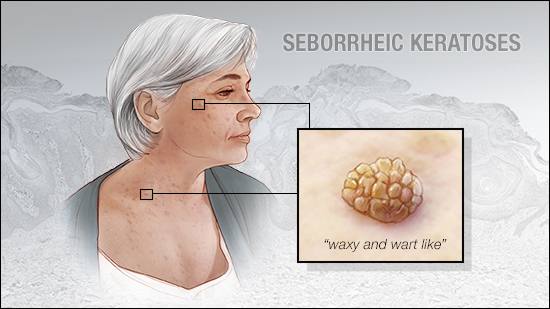-
Mayo Clinic Q and A: What are seborrheic keratoses?

DEAR MAYO CLINIC: I have brown spots over the top half of my body, which my doctor says are seborrheic keratoses and are harmless. What causes them, and is there a way to prevent more from appearing?
ANSWER: Seborrheic keratoses are a common skin issue, particularly in older adults. Although they don’t pose any health risks, these skin growths can be mistaken for a potentially more serious problem, such as skin cancer. Therefore, patients often seek care from a dermatologist when seborrheic keratoses develop.
Seborrheic keratoses usually appear as brown, black or light tan growths on the face, chest, shoulders or back. They have a waxy, scaly, slightly elevated appearance. Some people develop just a single growth, while others have clusters of them.
In most cases, seborrheic keratoses first develop in later adulthood, often after age 50, and they usually become more numerous with age. They occur in men and women equally, and the condition tends to run in families.
It's not clear why seborrheic keratoses develop, although genetics seem to play a role for some people. They don’t appear to be related to sun exposure or other environmental factors, so there’s no obvious way to prevent their appearance and growth.
Seborrheic keratoses do not turn into skin cancer, even after several years, And they don’t raise your risk for developing skin cancer or other skin problems. They are not contagious. Typically, the lesions aren’t painful, but they may itch. Be careful not to rub, scratch or pick at them, though. This can lead to bleeding, swelling and, in rare cases, infection. Depending on their size and location, seborrheic keratoses can become irritated or bothersome. If that happens — or if you would like to get rid of the growths for cosmetic reasons — you can discuss options for removing them with your health care provider.
Several removal methods are available, including freezing the growths with liquid nitrogen — a procedure known as cryosurgery. Cryosurgery can be effective, but it doesn’t always work on raised growths. And after the growth heals, the area of skin treated may be lighter than the surrounding skin. For thin or flat growths, a special instrument with a sharp blade can be used to shave the growth off the skin. That technique is known as curettage. An approach called electrocautery also may be effective. It uses an electric current to burn off the growth. Laser treatment can be used to remove seborrheic keratoses, as well. In some cases, a combination of these techniques may be most effective.
There is one prescription drug approved by the Food and Drug Administration for topical treatment of seborrheic keratoses. This medication, a form of hydrogen peroxide, needs to be administered in your health care provider's office, and the cost is not covered by most insurance companies. But it is a safe treatment alternative for people who want to eliminate seborrheic keratoses and who prefer not to use the other removal techniques.
Most of the time, seborrheic keratoses don’t require treatment. If you notice many growths developing over a short period of time, however, or if you see any suspicious changes in the seborrheic keratoses or in other areas of your skin — such as sores or growths that grow rapidly, bleed and don’t heal — see a dermatologist. Those could be signs of a more serious skin problem that requires evaluation. — Dr. Lawrence Gibson, Dermatology, Mayo Clinic, Rochester, Minnesota







